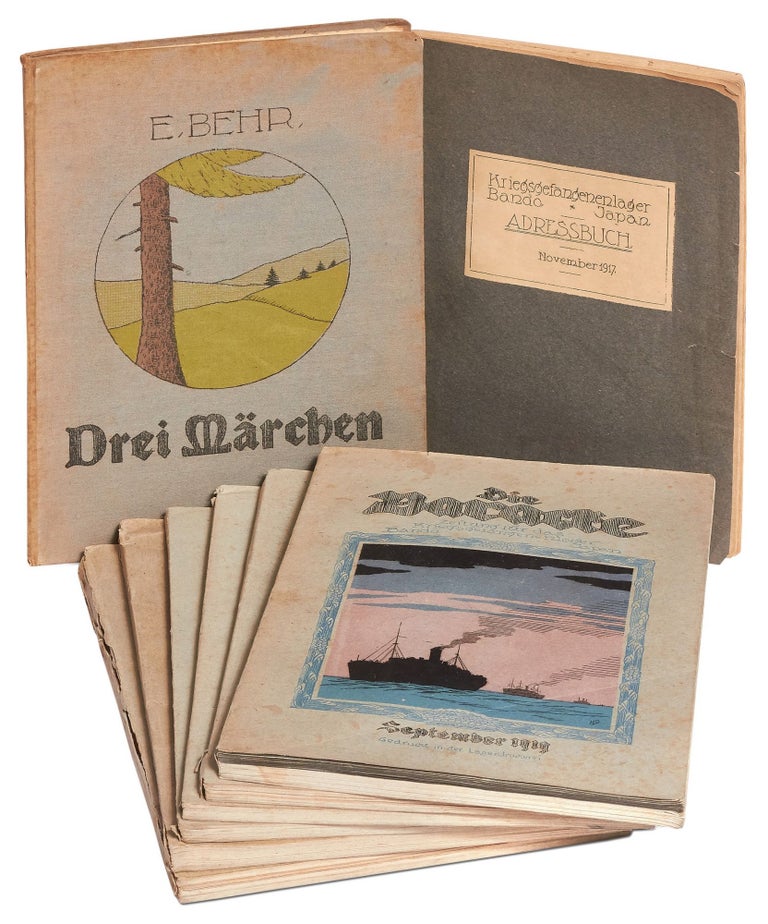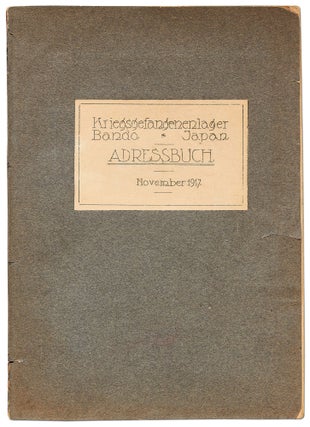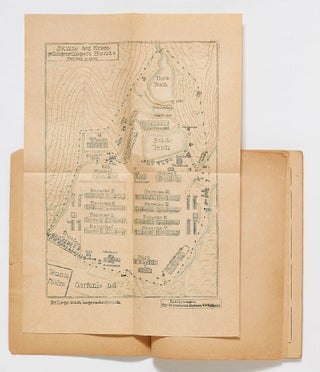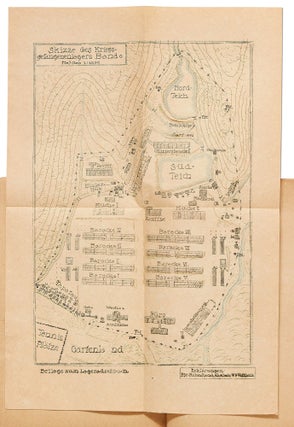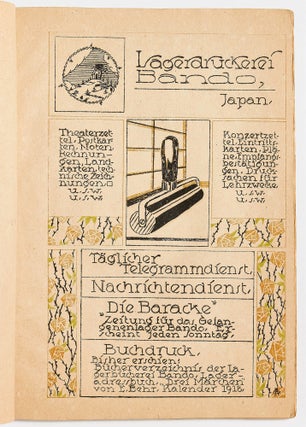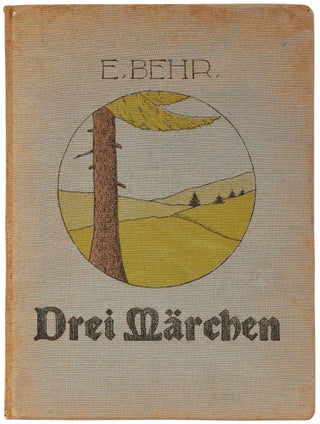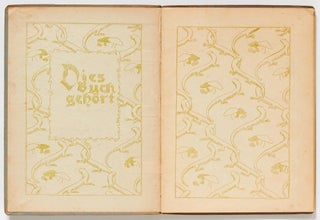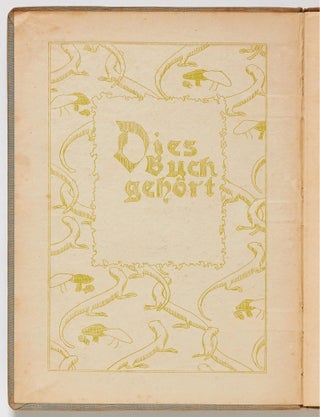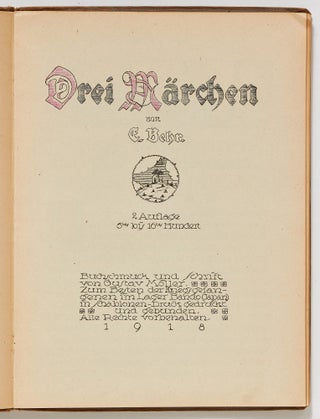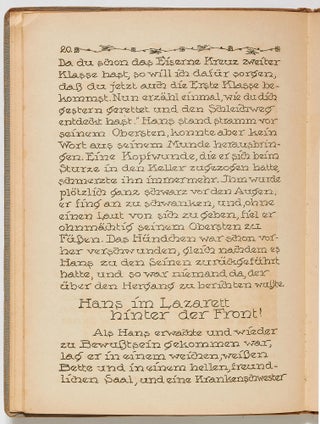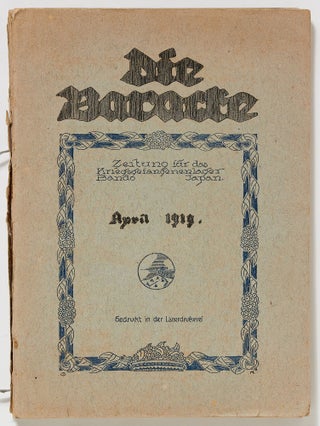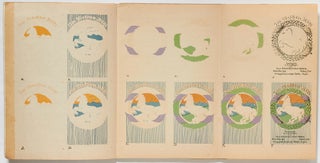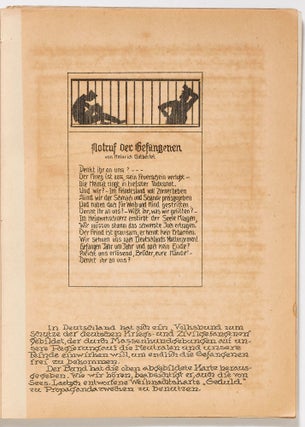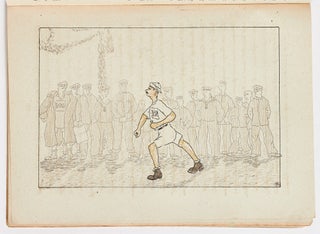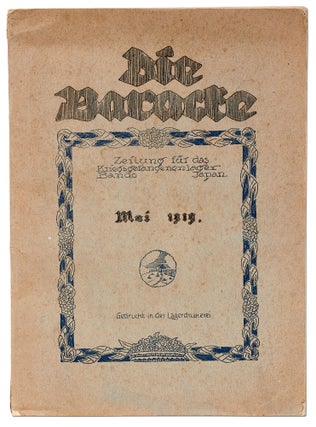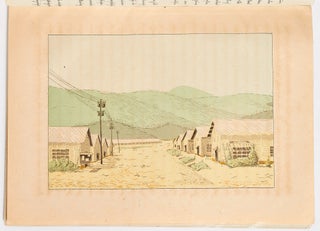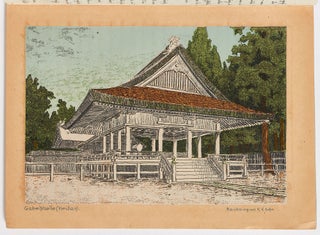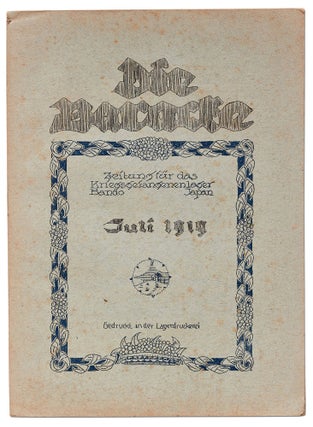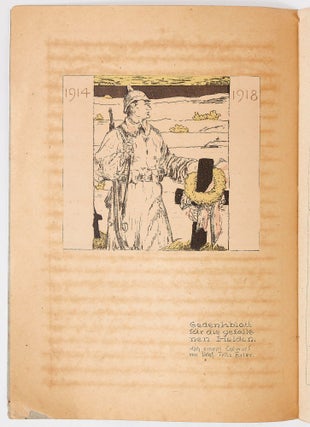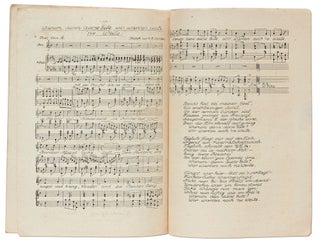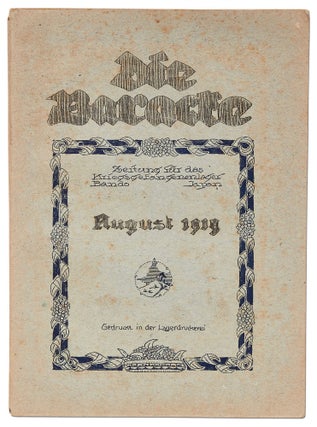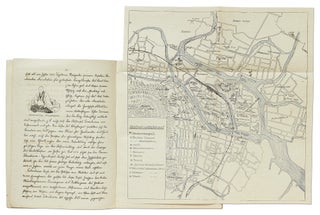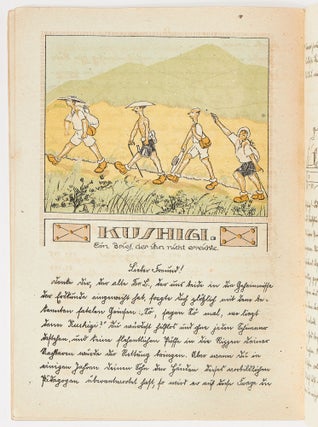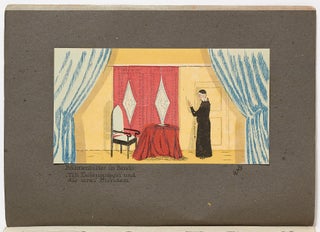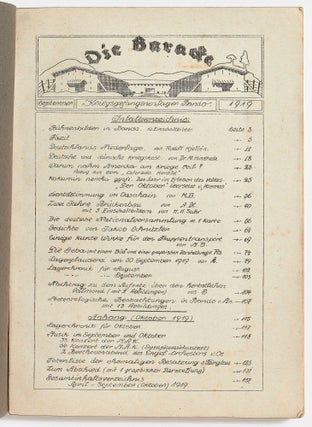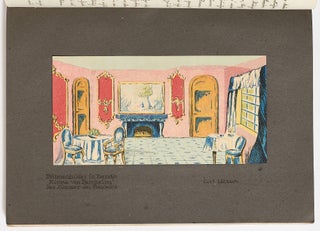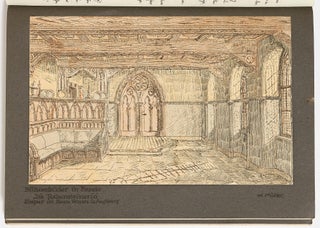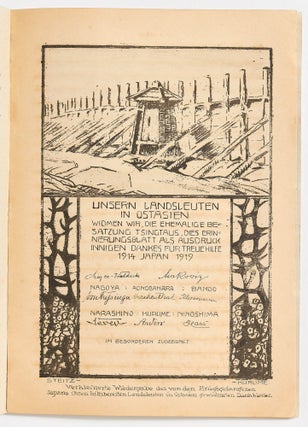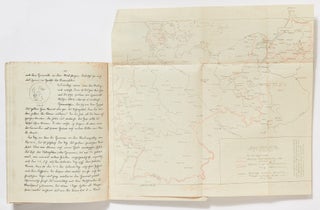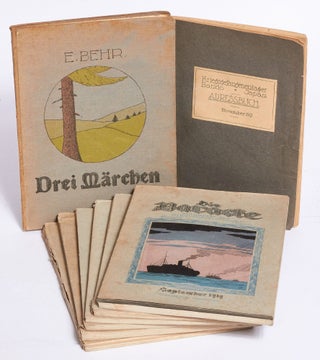Bando Kriegsgefangenenlager, Japan: Lagerdruckerei, (1917-19).
Price: $40,000.00
Softcover. A collection of eight rare printed items little known outside of Germany or Japan. The Bando POW Camp, located near Naruto, Japan, was set up in 1917 to house about one thousand German prisoners, both soldiers and civilians, who had been captured at Tsingtao, China. The collection includes the very rare camp directory: *Kriegsgefangenenlager Bando Adressbuch* (November 1917), with two fine color maps and advertisements; a beautifully illustrated children’s book: *Drei Märchen* meant to be sent home to family and friends in Germany; and the final six consecutive issues of *Die Baracke* (April – September, 1919), an illustrated monthly “Zeitung für das Kriegsgefangenenlager” [Newspaper for Prisoners of War]. All eight items are remarkably well-preserved, in very good to near fine condition.
Unlike other Japanese POW camps, the German prisoners at Bando were given an unusual level of freedom, and were allowed to establish several of their own community organizations, including a bakery, a theatrical troupe and orchestra, and a large scale printing house known as the “Lagerdruckerei.” At the press, which operated within the camp for just over two years, from 1917 to 1919, the German inmates pioneered a unique and highly sophisticated technique for printing in color on silk paper, and they published works with remarkably sophisticated and diverse content, including articles on Japanese culture, astronomy, politics, theatre, music, poetry, and political and military affairs, as well as an explanatory guide documenting their unique printing processes. Their various publications were illustrated with color plates, maps, diagrams, etc., of an astonishing high quality, when one considers the makeshift conditions in which they were produced. The works thus display unique technical qualities and content that could only have been created at the Bando camp.
A remarkable and historically important collection of materials, rarely if ever found together. Detailed descriptions of all eight items follows.
I. *Kriegsgefangenenlager Bando. Japan. Adressbuch. November 1917*.
[POW Camp Bando. Japan. Address Book. November 1917]. Edited by Rudolf Hülsenitz. Bando, Japan: Lagerdruckerei [Prison Camp Press]. Large octavo (7” x 10”). 79pp. Complete as printed with irregular pagination. Folding map tipped onto the inner front cover, 1 full-page map, 3 full-page color advertisements and 1 inserted color plate advertisement. In the original grey paper wrapper with printed paper title label on the front wrap. A few scattered small marginal tears to wrappers, near fine.
Edited by internee Rudolf Hülsenitz, this camp directory features a list of the prisoners in alphabetical order and their addresses in the camp. Also included is a guide to the camp’s shops, and information about the camp’s health services. Among the graphic highlights of the book are the two beautifully designed original maps. The folding map on the inner front cover depicts the core of the camp as it appeared in 1917, Bando’s first year of operation. It corresponds to the address list, depicting each barrack house (dormitory) and listing the names of the occupants according to their beds. Printed in blue, yellow, and black, it is accurate to scale and includes much topographical detail. The second, full-page map, printed on page 2, depicts the camp within its greater environs, including its barbed wire boundaries, the 8 barrack houses, sports grounds, post office, gardening area, fountains, police station, cemetery, chicken coops, its two ponds, music hall, tennis courts, botanical gardens, officers’ quarters, the kitchen, offices, as well as various other structures.
Also notable are the impressive color advertisements, including one for the Bando Lagerdruckerei itself, listing its publications to date. Other advertisements promote pharmacies, pastry shops, an exchange office, an art exhibition to be held in 1918, as well as a series of maps of other POW camps in Japan, and a printed celestial chart. Prior to the war Rudolf Hülsenitz was employed by the East Asia Lloyd shipping company in Shanghai, and joined the German Marine Corps in 1914.
A very scarce survival. *OCLC* locates only one known extant copy, at the Bayerische Staatsbibliothek in Munich.
II. Behr, E. *Drei Märchen [Three Stories]*.
Bando, Japan: Lagerdruckerei [Bando Prison Camp Press], 1918. Second edition. Quarto. pp. [2 (half-title)] [1-3] 4-79 [80 (blank)]. Illustrated with 8 color plates by Gustav Möller; illustrated title page with color initials; 3 other color initials; head and tail pieces. Bound in grey silk cloth over boards with a color illustrated cover, with printed endpapers featuring an art nouveau design of salamanders and mushrooms. Inscribed in ink by a Bando camp inmate on the half-title page (dated November, 1918). Some fading and a few tiny tears to the spine and light staining to the edges of the boards, very good or better.
An edition of three stories by Behr: 1. *Hans Wunderlich im Schützengraben* [Hans Wunderlich in a Trench]; 2. *Der Glückstaler* [The Chinese Money Plant]; and 3. *Die Sprechende Nactigall!* [The Talking Nightingale!]. As there were no children resident at the Bando Camp, *Drei Märchen* was specifically made to be sent home to children and relatives in Germany. This copy is inscribed by a Bando inmate to his niece Gisela, presumably in Germany. It is the second of two editions printed at the camp. *OCLC* locates only six copies: five in Germany and Japan, and one in the United States (San Jose State University).
III. *Die Baracke. Zeitung für das Kriegsgefangenenlager. [The Barracks. Newspaper for Prisoners of War]. Bando, Japan*.
Bando: Lagerdruckerei [Bando Prison Camp Press]. 1919. The final 6 consecutive monthly issues (April – September 1919). Illustrated with color and black & white plates and maps, several folded, and in-text illustrations. The various articles document the wide ranging cultural and scientific interests of the Bando camp inmate community. They also document the inmates’ liberal and progressive interest in comparing Western and Japanese cultures. The unique color printing process employed at Bando might have remained a mystery, had not one of the printers included a detailed guide, with illustrated examples, in the April issue. All six issues provide valuable information on daily life, news, and cultural activities at the camp. For example, the Bando prisoners introduced Beethoven’s Ninth Symphony to Japan, which has been immensely popular in Japan ever since. Surviving issues of *Die Baracke* are very scarce. A few German libraries hold some issues, and there an unspecified number of issues at the University of California, Santa Barbara.
A list of each issue follows:
1. April 1919. Quarto. Printed wrapper. pp. [1] 2-158 [4 (advertisements)]. Illustrated with a frontispiece plate printed in black and blue; one black & white plate; two color plates (one folded); one full-page color illustration; and with both black & white and color illustrations in text. The wrapper is detached and split along the spine with associated small tears, two-inch tear to the back wrap, else near fine. This issue includes an article on the printing techniques of the Bando Press illustrated with two color plates (one folded) with printed examples of continuous color proofs, musical scores and poetry, as well as reports on sporting events which took place within the camp.
2. May 1919. Quarto. Printed wrapper. pp. [1-2] 3-142 [2 (advertisements)]. Illustrated with a color frontispiece plate and one other color plate; two folded plates (one printed in black, the other in brown); and black & white illustrations in text. A few small tears to the spine ends, a bump to the top of the spine, near fine. This issue features articles on the Bolsheviks (the Communist faction that in 1917 assumed control over the Russian government); together with articles on music, sports, and theatre.
3. June 1919. Quarto. Printed wrapper. pp. [1-6] 7-119 [120 (advertisement)]. Illustrated with several plates and/or full-page illustrations (including one color plate, two color maps, and one folded black & white plate); and black & white illustrations in text. Near fine. This issue features numerous illustrated articles on Japanese art, culture and architecture, all conveyed with remarkable cultural sensitivity and evident admiration for the land in which the Bando Camp was located. It additionally includes articles on music, as well as an academically valuable statistical report on the physical activities of the prisoners.
4. July 1919. Quarto. Printed wrapper. pp. [1] 2-100 [101-104 (last page blank)]. Illustrated with a color frontispiece plate, black & white illustrations in text, music score and lyrics. Near fine. This issue features a review of a painting exhibition held within the camp, as well as reports on musical concerts and global military affairs, plus an article on what it’s like to be a German living amongst the Japanese.
5. August 1919. Quarto. Printed wrapper. pp. [1-2] 3-108. Illustrated with three color plates (including frontispiece); one folded color map; one black & white plate; one plate printed in black and grey; one color illustration in text, and black & white illustrations in text. Near fine. This issue features an illustrated article on the nearby Japanese city of Tokushima, including a large folding plan. It also contains a lengthy article comparing the European and Asian considerations of the Autumn Full Moon, accompanied by Moon Charts. Additionally, there are reports on global military affairs, as well as sports and musical events.
6. September 1919. Quarto. Printed wrapper. pp. [1-2] 3-135 [136 (blank)], [2] 1-8 (index). Illustrated with 10 color plates tipped-in on black paper, 4 full-page illustrated plates (printed in black, grey and/or white), 2 folded color maps, full-page charts and diagrams, and several in-text illustrations, including a full-page color illustration. Near fine. The final and most impressive issue of Die Baracke, containing special, lavishly illustrated articles meant to serve as a memento of the camp for the departing inmates. The front cover features a color illustration of a ship, symbolizing the Germans’ imminent return home. As theatre played a central role in the social and cultural life of Bando, this issue features 10 exquisite images of theatre scenes from plays performed within the camp, all printed in color on silk paper, tipped onto black paper mounts. Also included is a report on the final days of the Bando Printing Press, as well as statistics on the production of Die Baracke. There is also a detailed article on the current political situation back home in Germany, illustrated with large folding maps. Finally, there is an ‘In memoriam’ article with a listing of all the internees who died at Bando. Reference: Ichiro Tamura, *Hie gut Deutschland alleweg! Eine Einfuhrung in die Geschichte des Kregsgefangenenlagers Bando* (Bremen, 2011).
Item #423459


